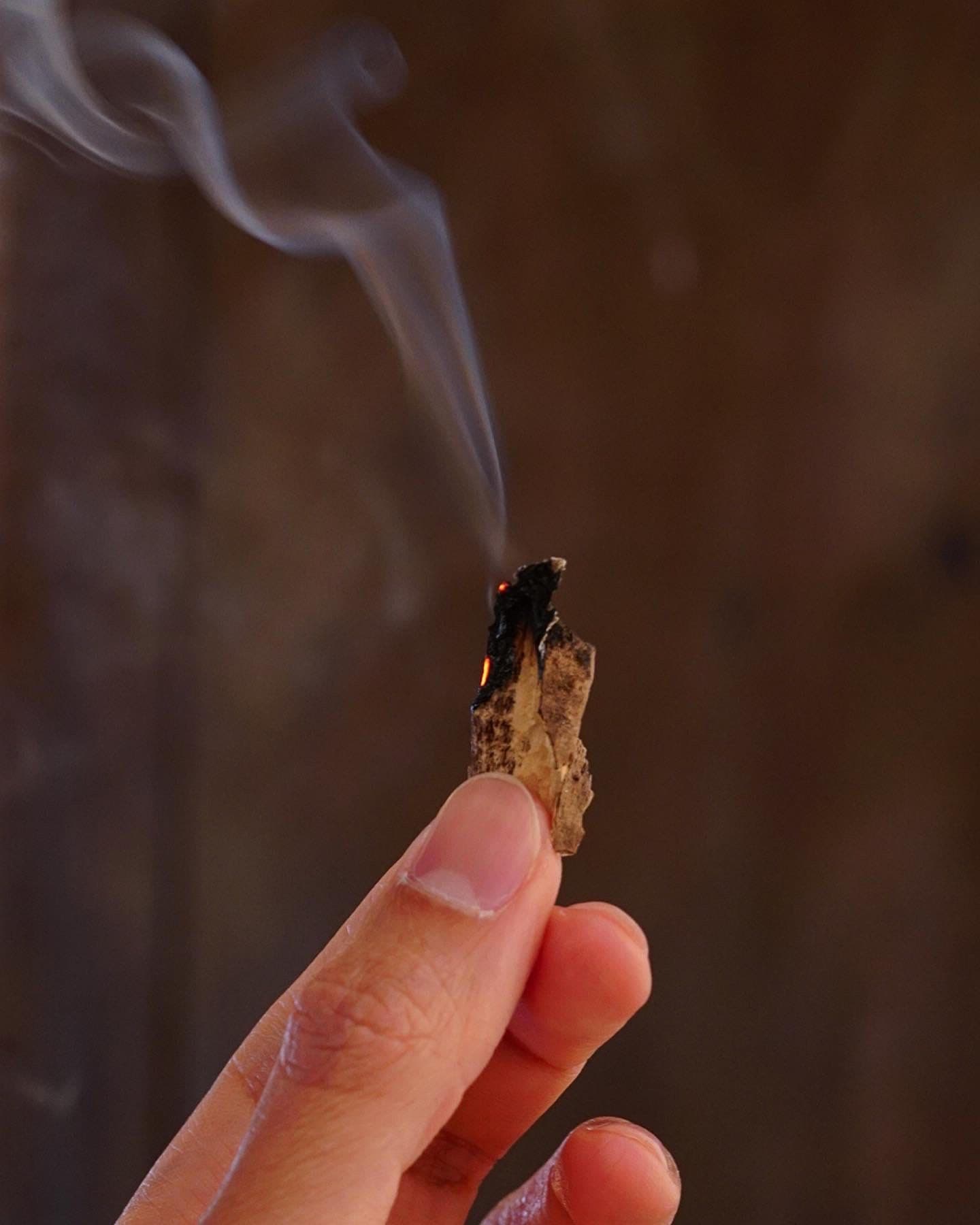Deep Scent
[ James Nguyen ]
Trầm Hương and Kỳ Nam are common names for Vietnamese Agarwood. Trầm Hương means deep scent. Rarer than gold, Agarwood has been burnt as incense across India, China, Japan, the Middle East and the Mediterranean for countless generations. Extracted and sourced from the jungles of Southeast Asia and India, Agarwood has now become almost extinct in the wild.

Spirit House, an Agarwood burning ritual for staff at the exhibition Open Glossary, co-commissioned by ACCA and Copyright Agency, 2023. Photo: James Nguyen.
For thousands of years, this precious commodity was foraged and traded, connecting peoples, cultures and religions. From Islam to Buddhism, Daoism to Hinduism and Christianity, centres like Hong Kong (known as the fragrant harbour), Singapore and Dubai have become established as key trading hubs for the fragrant wood.
Whilst the Islamic world prized Cambodian Oudh, the Japanese market sought Vietnamese Kỳ Nam. Dividing the remnant jungles of Cambodia and Vietnam is the high country where wild Agarwood once supplied the entire world. During the Vietnam-American War, the jungles on both sides of this border region were saturated in Agent Orange, with huge tracts of land and rural villages singed by napalm and white phosphorus.
It is estimated that over a quarter of South Vietnam’s forests were destroyed by chemical weapons and defoliants. 'Operation Ranch-Hand' sprayed over 11 million gallons (50 million litres) of Agent Orange in Vietnam to lay bare the jungle, exposing enemy operatives and killing crops and harvests to drive hungry farmers into American controlled centres. The Ho Chi Minh Trail, snaking from China through to the jungles of Laos and Cambodia, was also sprayed with these chemical weapons. But existing beyond the legal jurisdictions of war, records were rarely kept and the extent of dumping chemicals weapons in Cambodia and Laos remains largely unknown.
No records have ever been found of the extent of damage to the wild and remnant Agarwood species that were once endemic in the highlands of Vietnam, Cambodia and Laos. The aftermath of war made utterly impossible the monitoring of illegal poaching and smuggling of Agarwood resin across borders, let alone the profound environmental damage and loss of ancient forests and trees by these chemical weapons. The incendiary vaporisation of these ancient incense forests goes beyond the spiritual.
Seeping into waterways and up the food chain, white phosphorus, napalm and Agent Orange not only burned into the flesh of people and trees, but biologically scarred the DNA of people. Communities exposed to these chemicals, including soldiers, civilians and manufacturers and their children have been afflicted with birth defects, cancer clusters and auto-immune abnormalities.
Even the landscapes and peoples living far from mainland Southeast Asia are haunted and saturated by the chemical industrial complex of war. Homebush Bay in Sydney, once a significant manufacturer of Agent Orange is contaminated by Dioxins and other teratogens that accumulate in the fish and crustaceans of Parramatta River and Sydney Harbour. Sites in North Queensland where these chemicals were tested in the tropical rainforest of Mamu Country have unusually high reports of cancer clusters in local Aboriginal, military and farming communities.
Traditionally, the only way to allay these profound hauntings and troubling curses is to burn incense offerings to our troubled ancestors and cleanse the land from the spirits of war. The only incense we can afford now is made in factories or at best from farmed Agarwood oil.
Notes
Rozi Mohamed (ed.), Agarwood: Science Behind the Fragrance, Singapore: Springer, 2016, https://doi.org/10.1007/978-981-10-0833-7.
United States Government Accountability Office, “Use of Agent Orange in Vietnam,” GAO, 16 August 1978, https://www.gao.gov/products/ced-78-158#:~:text=Concerns%20have%20been%20expressed%20about,gallons%20per%20acre%20sprayed%20undiluted.
George Black, “The Victims of Agent Orange the U.S. Has Never Acknowledged,” The New York Times, 16 March 2021, https://www.nytimes.com/2021/03/16/magazine/laos-agent-orange-vietnam-war.html.
Wilbur J, Scott, “Competing Paradigms in the Assessment of Latent Disorders: The Case of Agent Orange,” Social Problems 35, no. 2 (April 1988): 145–161, https://www.jstor.org/stable/800737.
Boi Huyen Ngo, “The Haunting of Agent Orange within the Waters of Rivers andBodies for Vietnamese Australians,” AJE: The Australasian Journal of Ecocriticism and Cultural Ecology 6 (2016), https://openjournals.library.sydney.edu.au/Swamphen/article/view/11477; Editor’s note: James Nguyen, Open Water, 2016, for the author’s expanded engagement with this research area, https://www.jamesnguyens.com/projects/pure-water.
The Habitat Advocate, “America & Australia culpable for Agent Orange,” Deep Silent blog, 4 January 2012, https://habitatadvocate.com.au/tag/gregory-falls/.
Artist
James Nguyen
James Nguyen was born in Bảo Lộc, Việt Nam in 1982. He currently lives and works in Naarm, Melbourne. Nguyen’s work engages with decolonial practice and minoritarian language-brokering. This is explored in how ethnic poetry, performance, cinema, sculpture and cinematography can trouble settler-colonialism, the diasporic absurd, and of course, gambling. Nguyen has presented work throughout Australia and abroad since 2013, regularly doing performances for local and international exhibitions, festivals and community events. Notable presentations include Guangzhou Academy of Fine Arts, Guangzhou, 2014; Sculpture by the Sea, Sydney, 2014; the Australian War Memorial and the Australian Government at Sàn Art, Hồ Chí Minh City, 2018; alongside collaborative projects including Sentient: Murray River with Abigail Moncrief at the Murry Art Museum Albury, 2018; CONNECT with Victoria Pham, curated by Tamsen Hopkinson at Footscray Community Arts Centre, 2021; Re-Tuning in collaboration with Victoria Pham, curated by Michael Do at the Sydney Opera House, 2022. Nguyen's 2018 project Pure Water, a collaboration with Eben Kirksey and Jessamine Chen, expanded on the artist's interest in dioxin presence in the Parramatta River.